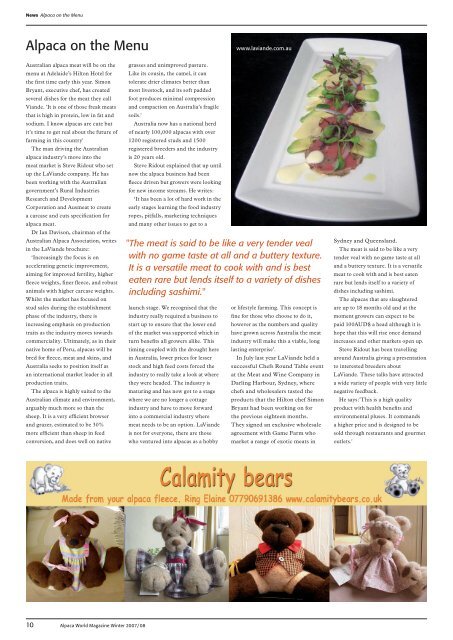Winter - Classical MileEnd Alpacas
Winter - Classical MileEnd Alpacas
Winter - Classical MileEnd Alpacas
You also want an ePaper? Increase the reach of your titles
YUMPU automatically turns print PDFs into web optimized ePapers that Google loves.
News Alpaca on the Menu<br />
Alpaca on the Menu<br />
www.laviande.com.au<br />
Australian alpaca meat will be on the<br />
menu at Adelaide’s Hilton Hotel for<br />
the first time early this year. Simon<br />
Bryant, executive chef, has created<br />
several dishes for the meat they call<br />
Viande. 'It is one of those freak meats<br />
that is high in protein, low in fat and<br />
sodium. I know alpacas are cute but<br />
it’s time to get real about the future of<br />
farming in this country'<br />
The man driving the Australian<br />
alpaca industry’s move into the<br />
meat market is Steve Ridout who set<br />
up the LaViande company. He has<br />
been working with the Australian<br />
government’s Rural Industries<br />
Research and Development<br />
Corporation and Ausmeat to create<br />
a carcase and cuts specification for<br />
alpaca meat.<br />
Dr Ian Davison, chairman of the<br />
Australian Alpaca Association, writes<br />
in the LaViande brochure:<br />
‘Increasingly the focus is on<br />
accelerating genetic improvement,<br />
aiming for improved fertility, higher<br />
fleece weights, finer fleece, and robust<br />
animals with higher carcase weights.<br />
Whilst the market has focused on<br />
stud sales during the establishment<br />
phase of the industry, there is<br />
increasing emphasis on production<br />
traits as the industry moves towards<br />
commerciality. Ultimately, as in their<br />
native home of Peru, alpacas will be<br />
bred for fleece, meat and skins, and<br />
Australia seeks to position itself as<br />
an international market leader in all<br />
production traits.<br />
The alpaca is highly suited to the<br />
Australian climate and environment,<br />
arguably much more so than the<br />
sheep. It is a very efficient browser<br />
and grazer, estimated to be 30%<br />
more efficient than sheep in feed<br />
conversion, and does well on native<br />
grasses and unimproved pasture.<br />
Like its cousin, the camel, it can<br />
tolerate drier climates better than<br />
most livestock, and its soft padded<br />
foot produces minimal compression<br />
and compaction on Australia’s fragile<br />
soils.'<br />
Australia now has a national herd<br />
of nearly 100,000 alpacas with over<br />
1200 registered studs and 1500<br />
registered breeders and the industry<br />
is 20 years old.<br />
Steve Ridout explained that up until<br />
now the alpaca business had been<br />
fleece driven but growers were looking<br />
for new income streams. He writes:<br />
‘It has been a lot of hard work in the<br />
early stages learning the food industry<br />
ropes, pitfalls, marketing techniques<br />
and many other issues to get to a<br />
"The meat is said to be like a very tender veal<br />
with no game taste at all and a buttery texture.<br />
It is a versatile meat to cook with and is best<br />
eaten rare but lends itself to a variety of dishes<br />
including sashimi."<br />
launch stage. We recognised that the<br />
industry really required a business to<br />
start up to ensure that the lower end<br />
of the market was supported which in<br />
turn benefits all growers alike. This<br />
timing coupled with the drought here<br />
in Australia, lower prices for lesser<br />
stock and high feed costs forced the<br />
industry to really take a look at where<br />
they were headed. The industry is<br />
maturing and has now got to a stage<br />
where we are no longer a cottage<br />
industry and have to move forward<br />
into a commercial industry where<br />
meat needs to be an option. LaViande<br />
is not for everyone, there are those<br />
who ventured into alpacas as a hobby<br />
or lifestyle farming. This concept is<br />
fine for those who choose to do it,<br />
however as the numbers and quality<br />
have grown across Australia the meat<br />
industry will make this a viable, long<br />
lasting enterprise’.<br />
In July last year LaViande held a<br />
successful Chefs Round Table event<br />
at the Meat and Wine Company in<br />
Darling Harbour, Sydney, where<br />
chefs and wholesalers tasted the<br />
products that the Hilton chef Simon<br />
Bryant had been working on for<br />
the previous eighteen months.<br />
They signed an exclusive wholesale<br />
agreement with Game Farm who<br />
market a range of exotic meats in<br />
Sydney and Queensland.<br />
The meat is said to be like a very<br />
tender veal with no game taste at all<br />
and a buttery texture. It is a versatile<br />
meat to cook with and is best eaten<br />
rare but lends itself to a variety of<br />
dishes including sashimi.<br />
The alpacas that are slaughtered<br />
are up to 18 months old and at the<br />
moment growers can expect to be<br />
paid 100AUD$ a head although it is<br />
hope that this will rise once demand<br />
increases and other markets open up.<br />
Steve Ridout has been travelling<br />
around Australia giving a presentation<br />
to interested breeders about<br />
LaViande. These talks have attracted<br />
a wide variety of people with very little<br />
negative feedback.<br />
He says:'This is a high quality<br />
product with health benefits and<br />
environmental pluses. It commands<br />
a higher price and is designed to be<br />
sold through restaurants and gourmet<br />
outlets.'<br />
10 Alpaca World Magazine <strong>Winter</strong> 2007 / 08







